With 29 different snake species slithering across the state, the Cornhusker State has a ton of variety! The flat grasslands, sandhills, and famous rocky outcroppings that make up the Nebraska landscape provide perfect habitats for snakes. Although there are many different kinds of snakes in Nebraska, only four are venomous — and three of those are rare.
While snakes make many people nervous or outright terrified, they’re almost always more afraid of you than the other way around.
Snakes fill a unique place in the natural world. They’re both predator and prey, meaning that most of them behave like their tail is on fire when you pick them up. Simply put — the snake is afraid you’re going to eat it!
Let’s explore a few of them.
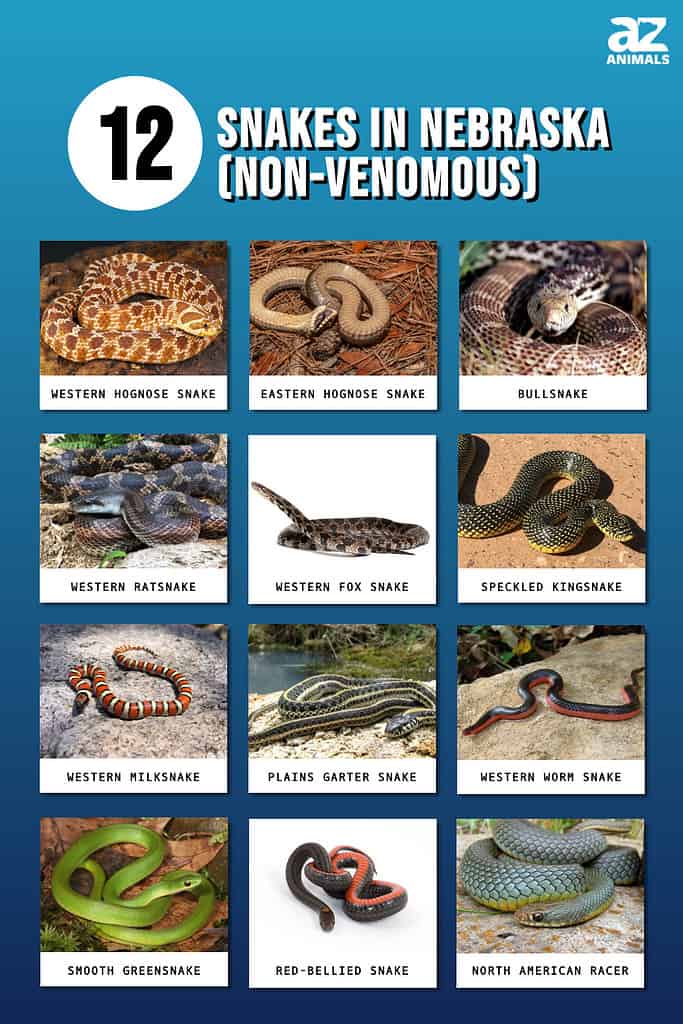
Hognose Snakes
Two of the four North American hognose snakes occur in Nebraska. These snakes are usually between 12 and 45 inches, with stout bodies, keeled scales, and a cute snout that turns up at the tip. Hognose snakes sometimes get mistaken for rattlesnakes because of their patterns, but rattlesnakes don’t play dead when you corner them.
Hognose snakes are popular on YouTube for their theatrical defensive tactics. All four species do a fantastic imitation of a dead and rotten snake! They’ll coil up, musk, or poop on themselves and spread it all over, flip onto their backs, and hang their tongue out of their wide-open mouths. But that’s after they’ve spread their baby-sized hood and tried desperately to make themselves bigger. What you’ll notice if you find one of these snakes playing dead is that they seem to look around before deciding if it’s safe to ditch the act!
These snakes are toad specialists. They’ll eat other prey but strongly prefer toads and other amphibians. It’s something that makes getting baby hognoses in captivity started difficult.
Interestingly, although they’re harmless to people and nearly all pets, hognose snakes are rear-fanged and have mild venom. Their venom is prey-specific and only really affects their main foods. There’s also a question as to whether their toad-eating habits might also make them poisonous, but we need more research to be certain.
Western Hognose Snake (Platirhinos nasicus)
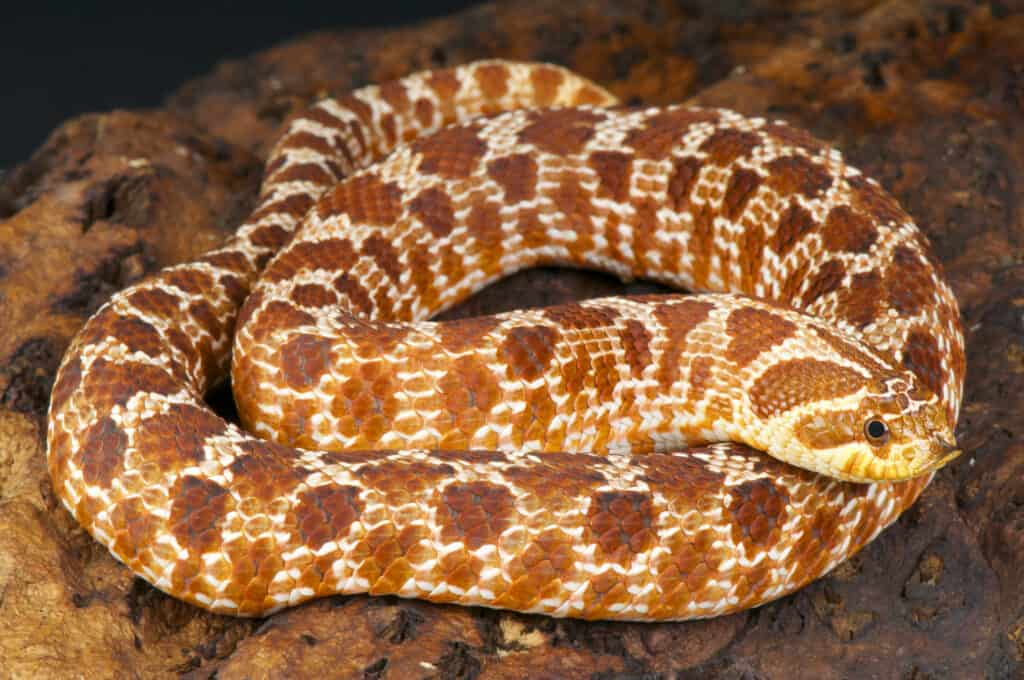
Western hognose snakes are almost as dramatic as their eastern cousins!
©reptiles4all/Shutterstock.com
The more common of the two Nebraska native hognoses are western hognose snakes. Their Nebraska range covers the western two-thirds of the state. They vary from dark to light base colors with darker spots over the top, and these harmless snakes love burrowing in loose sandy soil for prey.
Western hognoses are most active from April to early October and measure 12 to 45 inches.
Eastern Hognose Snake (Platirhinos heterodon)
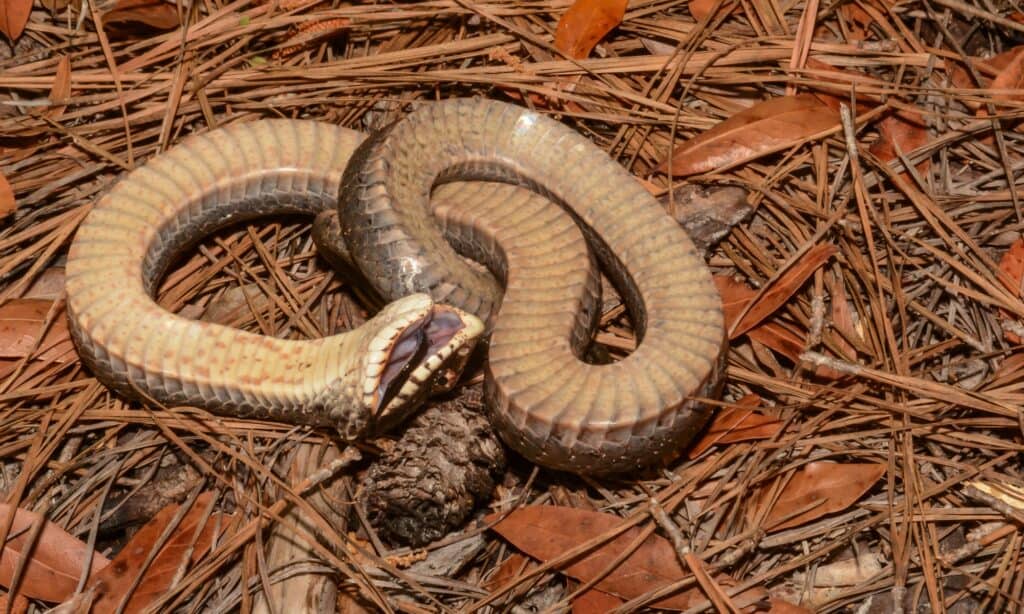
The eastern hognose snake is an amazing actor. Here’s one playing dead.
©iStock.com/JasonOndreicka
These snakes are in a couple of regions of Nebraska — a small southwestern pocket and along the northeastern and eastern border. Their snouts aren’t quite as upturned as the western hognose, and they tend to get darker than the western species, but they are usually more dramatic.
Eastern hognose snakes are active from April to October and are typically between 15 and 39 inches. This species is more dedicated to the “dead snake” act and will often keep it going longer than the others.
Bullsnake (Pituophis catenifer sayi)

©iStock.com/92968526
If you’re hiking, camping, or just enjoying the outdoors and you see a snake, take a breath. It may not be a rattlesnake, but instead, one of these master bluffers. Bullsnakes are known for feeding on mice, rats, and other vermin that can cause a lot of damage to crops and buildings, making them welcome on many farms.
People mistake them for prairie rattlesnakes because their colors and markings are similar. But bullsnakes are much longer than their rattlesnake doppelgangers and have no venom, fangs, or rattles.
Bullsnakes can be over eight feet long, making them one of the longest North American snake species. As part of their “please don’t eat me” act, they try their best to look big and scary. They’ll puff up, hiss loudly, coil up, rattle their tail against the ground, and even headbutt you. However, the moment they’re picked up, they calm down.
These snakes are widespread across Nebraska and are most active from May to October.
Western Ratsnake (Pantherophis obsoletus)
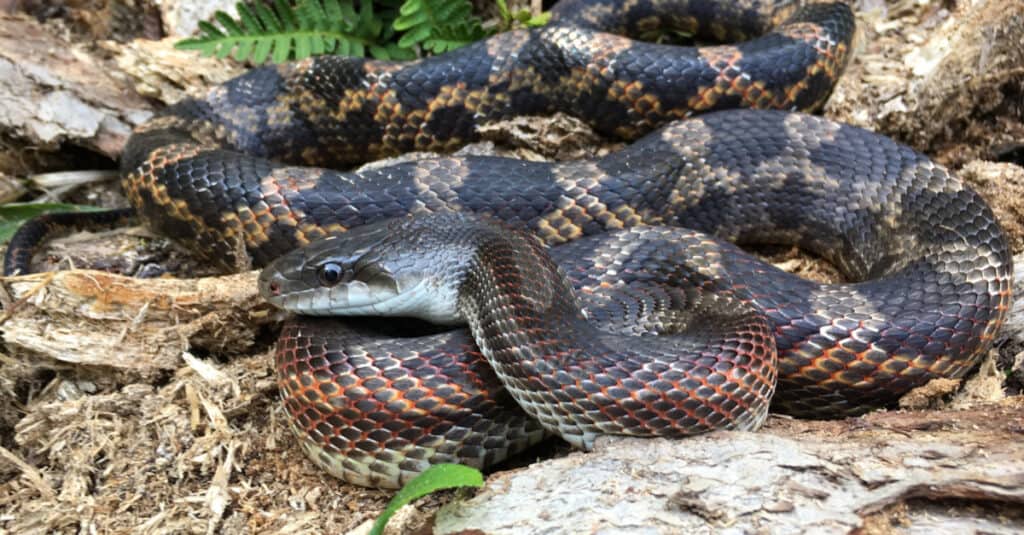
Western rat snakes darken with age and lose some of their patterns.
©Joe Farah/Shutterstock.com
Did you see a snake in your garage rafters or hanging around your porch light? It may have been a ratsnake. These snakes always manage to make an entrance in style. They’ll either climb up the lamp post, hide in your ceiling fan, or look in the window at you — fortunately, they’re harmless.
Western ratsnakes are also very long, and some of them exceed eight feet long. They’re amazing climbers and go anywhere they can in search of a meal. Western ratsnakes eat a lot of rodents but also take nestling birds and other small prey.
Unlike bullsnakes, western ratsnakes only inhabit the eastern edge of Nebraska, so seeing one in Nebraska is a treat. They’re active from early April to mid-October.
Western Fox Snake (Pantherophis ramspotti)
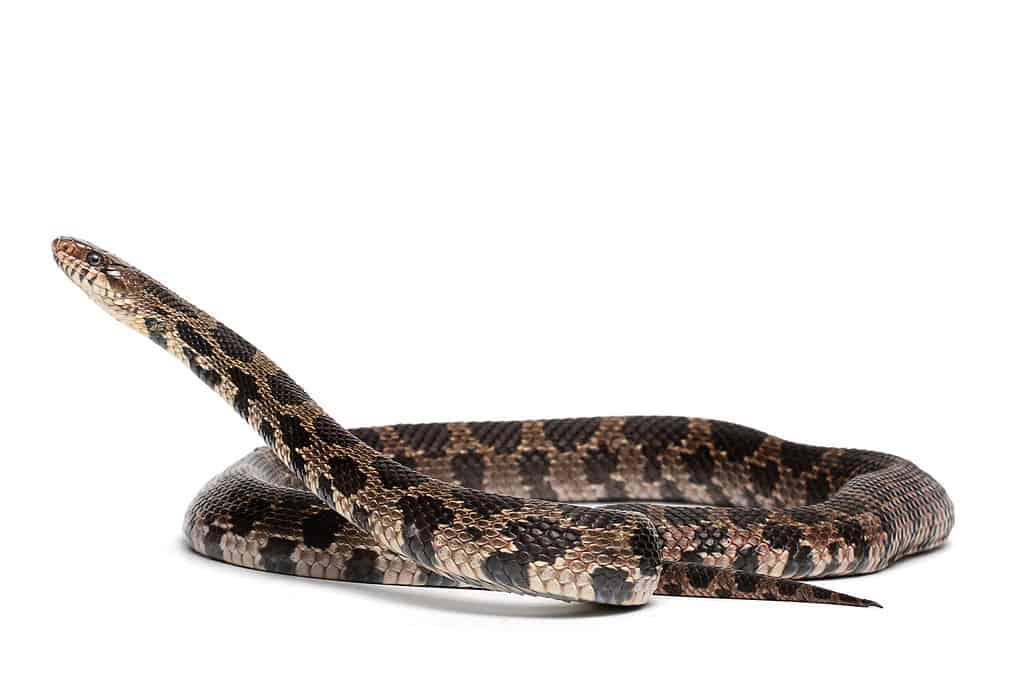
Because of a naming change, western and eastern foxsnakes are often called by each other’s names.
©Michiel de Wit/Shutterstock.com
This species has had all sorts of naming changes over the last 100 years or so. Currently, these ratsnake cousins are called western fox snakes. Unlike their ratsnake cousins, they’re not as big on climbing, even though they’re great climbers.
This species has similar markings to other ratsnakes but a shorter, flattened snout and a golden brown base color. Fox snakes are usually three to six feet long and give off a musk that smells similar to foxes, giving them their common name.
Western fox snakes are bold and don’t have a problem living alongside humans, even though they prefer forests, grasslands, and freshwater wetlands. These snakes eat mice and rodents but take other prey items like young rabbits, frogs, and eggs. You’ll only find western fox snakes in eastern Nebraska, usually scoping out something to eat from early April to early October.
Speckled Kingsnake (Lampropeltis holbrooki)
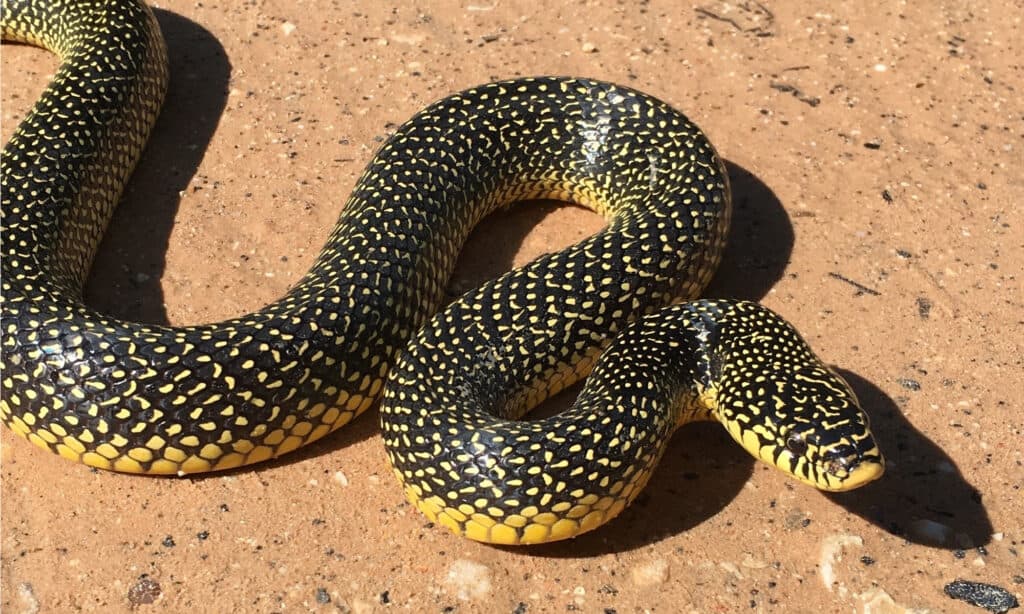
Big-bodied and strong, speckled kingsnakes sometimes eat other snakes, including venomous species.
©Joe Farah/Shutterstock.com
One of the most beautiful snakes in North America lives in the southeast corner of Nebraska. Speckled kingsnakes have a little yellow dot in the middle of most of their jet-black scales. These snakes grow up to six feet long and eat birds, bird eggs, small rodents, and of course, other snakes.
Speckled kingsnakes are usually calm and avoid people, but they’ll defend themselves! If you need to move one out of your yard or across the road, move slowly but expect them to try and bite.
This nonvenomous species only lives in the southeastern corner of Nebraska and is most active from mid-April to early October.
Western Milksnake (Lampropeltis gentilis)

Western Milksnake
©Matt Jeppson/Shutterstock.com
Another common but beautiful snake, the western milksnake is a type of kingsnake. They’re harmless unless you happen to be a rodent, small reptile, or bird, and their vibrant colors make a beautiful find if you’re out herping.
Lest you confuse them for a coral snake (which is not native to Nebraska), western milksnakes usually have red heads and a black snout, followed by narrow black bands alternating with wider white and red or orange bands.
Most active between early April and late October, western milksnakes are usually nocturnal and grow 35 to 54 inches long.
Plains Garter Snake (Thamnophis radix)
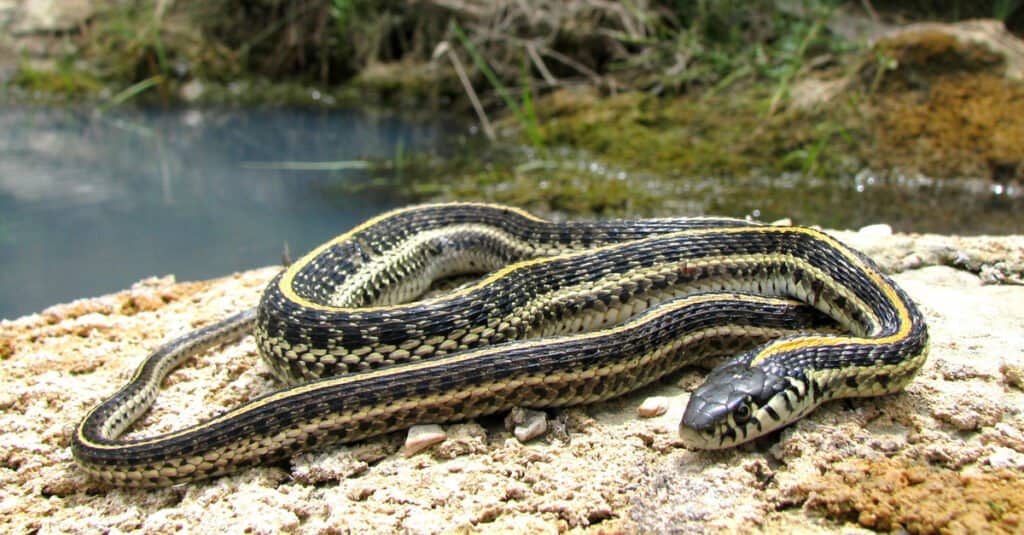
Plains garter snakes usually have a bright orange or yellow stripe on their back and a lighter stripe on either side of their body.
©Joe Farah/Shutterstock.com
Like most garter snakes, the plains garter snake is long, thin, and semi-aquatic. They are almost always found near permanent water sources with abundant worms, slugs, fish, and amphibians to eat. This species has an orange or yellow dorsal stripe that starts behind the head and extends all the way to the tail and a single light-colored stripe on each side. Their base color is usually dark, and they have a row of alternating black spots above and below the side stripe.
Plains garter snakes are widespread, inhabiting wet habitats all over Nebraska. They vary between 15 and 43 inches long, and you’re most likely to find them active from March to October.
Western Worm Snake (Carphophis vermis)
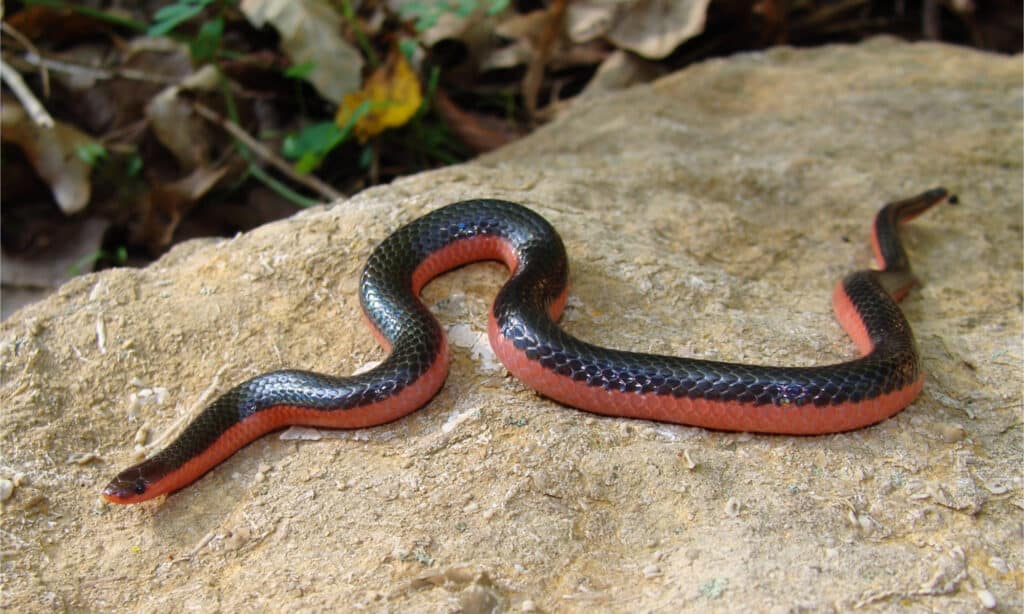
Western worm snakes are purplish on top and pink or orange on the bottom, with sharply pointed tails.
©Matt Jeppson/Shutterstock.com
This snake is fossorial and restricted to the southeastern corner of Nebraska, and active from spring to mid-fall.
Western worm snakes are rarely seen because they spend nearly all of their lives under rocks, leaf litter, logs, and other moist areas. They have smooth, glossy scales, small heads, eyes, and a pointy tail.
These snakes eat earthworms, very small snakes, and soft-bodied insect larvae. Western worm snakes use their pointy tail to help immobilize prey while they start eating it. They’re so small that at first glance, some people think they’re worms — these snakes grow seven to 15 inches long and are utterly harmless.
Smooth Greensnake (Opheodrys vernalis)

Smooth green snakes have smooth scales along their backs.
©iStock.com/tamers1
With a vibrant green back and yellow or white belly, smooth green snakes are gorgeous — if you can find them. These thin snakes only measure between 11 and 32 inches long and match their wet, grassy habitat perfectly.
This species is more common in central and eastern Nebraska and most active from mid-April to late September. Smooth green snakes’ diet is mostly insects and invertebrates but also includes small salamanders. They’re harmless and almost never bite.
One interesting thing is that some hatchlings are blue when they hatch, and some adult snakes turn blue after they die. When this happens, it’s because the yellow pigment fades, leaving behind the blue pigment.
Red-Bellied Snake (Storeria occipitomaculata)
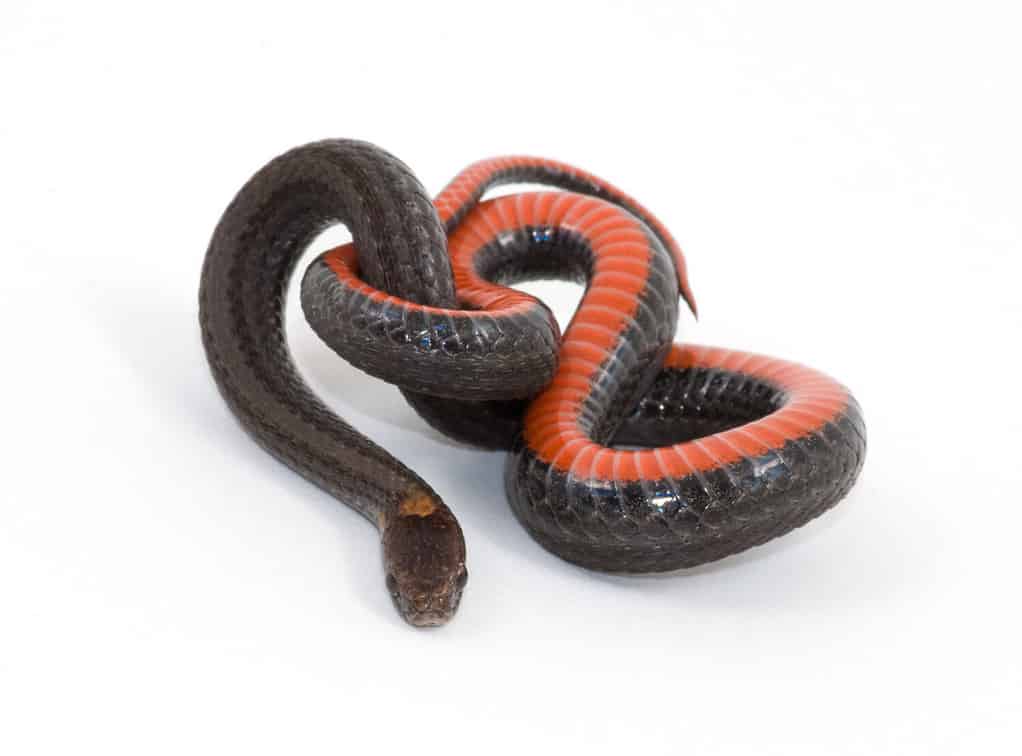
Red-bellied snakes are cousins to Dekay’s brownsnake and live in similar habitats.
©Gerald A. DeBoer/Shutterstock.com
These harmless and small snakes grow from about eight to 16 inches long. Their backs are dark brown, red, or gray, with bright orange or red bellies. They sometimes have a lighter dorsal stripe, but not often. They’re most active from March to October and only occur in south-central Nebraska.
Red-bellied snakes completely rely on slugs, snails, worms, and occasionally insects for food. They’re most active from March to October and spend most of their lives under moist leaf litter, rotten logs, and rocks — where their favorite foods also hide.
North American Racer (Coluber constrictor)
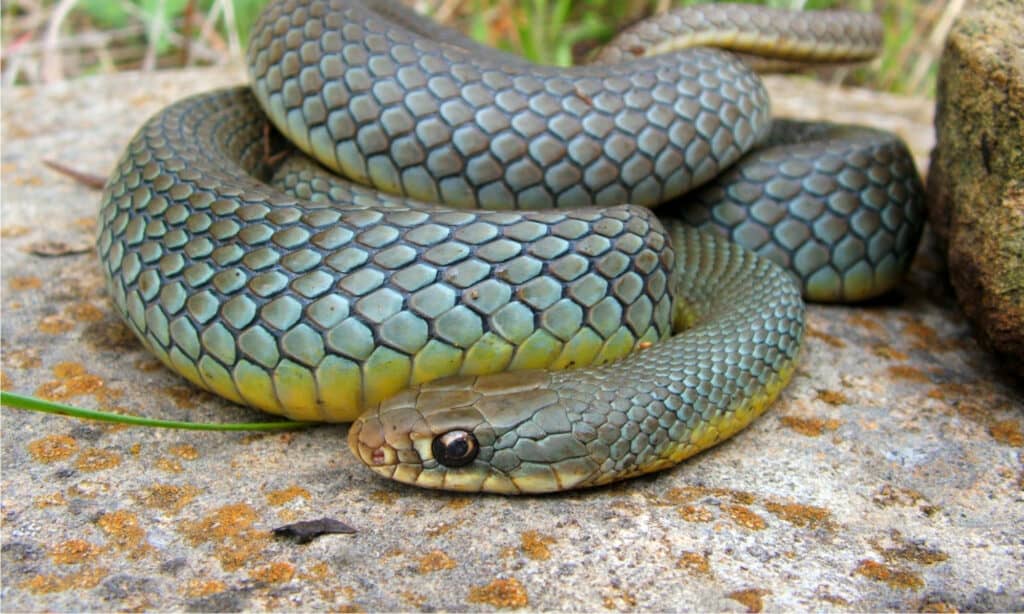
A large and colorful Eastern Yellow-bellied Racer snake, Coluber constrictor flaviventris, coiled defensively with a large meal in its belly.
©Matt Jeppson/Shutterstock.com
Racers are any of several North American Racer subspecies that occur throughout much of the United States. In Nebraska, you’re most likely to encounter the eastern yellow-bellied racer, which can be olive green to greenish blue on the back and yellow to white on the belly.
They’re widespread throughout Nebraska and are most active from early April to September. These snakes are long and thin with big eyes — they often reach six feet long. Young snakes have strong patterns that look similar to prairie kingsnakes, but they fade into their adult pattern by the time they’re around two years old.
North American racers enjoy cruising through open woodlands, grasslands, and agricultural fields, where they hunt everything from small rodents to birds, eggs, amphibians, and even the occasional snake. They’re one of the fastest snakes in North America and slither along at about four miles per hour. Sure, maybe you could walk faster than that, but these snakes do it legless.
Venomous Snakes In Nebraska
There are four different types of venomous snakes in Nebraska. The only widespread venomous snake is the prairie rattlesnake; all others are rare and isolated to the southeastern region.
Nebraska’s venomous snakes are all pit vipers and have a single heat-sensing pit located on each side of their head, between their nostril and eyes. All but the copperhead is a rattler, and none of them are aggressive.
They have a few things in common:
- Long hollow fangs that fold up into the mouth.
- Bigger heads on thin necks
- Thick bodies with keeled scales.
- Vertical pupils, which you can see in brighter light.

Eastern Copperhead Snake (Agkistrodon contortrix)
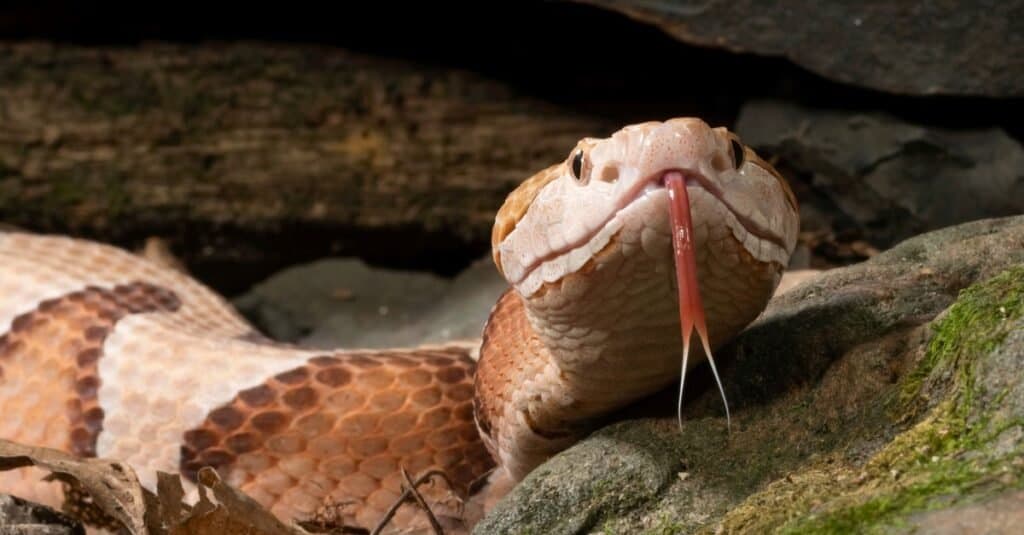
Copperhead snake
©Joe McDonald/Shutterstock.com
The eastern copperhead snake is a venomous snake that only occurs in far southeastern Nebraska. They are most active from about April until about October when the weather is warm enough, then brumates through the cold winter.
They prefer to live and hunt in deciduous forests with plenty of leaf litter but also inhabit rocky outcroppings, farm fields, and any other area — with or without humans. Copperheads are on the smaller side and usually only reach about three feet long. These snakes eat lizards, insects, and small rodents; young snakes sometimes climb trees to chase cicadas.
Although you would think that color and vivid “chocolate kiss” markings make them hard to miss, these snakes are actually hard to see! Their markings help them camouflage perfectly on the ground, where they freeze instead of moving away.
Copperheads aren’t aggressive, and their venom is not as dangerous as most rattlesnakes. However, they’re still responsible for nearly half of all venomous snake bites in the U.S.
Prairie or Western Massasauga (Sistrurus tergeminus tergeminus)
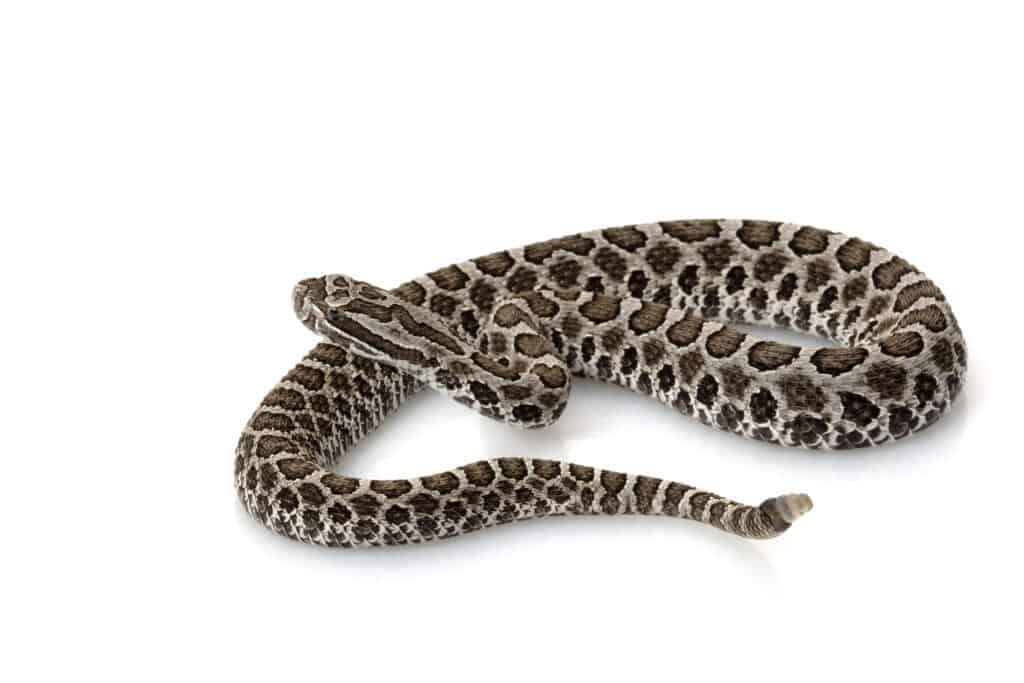
Massasaugas have several large scales near the front of their heads but don’t get too close — they’re venomous.
©fivespots/Shutterstock.com
Massasauga snakes are not large. In fact, they can be as short as just 14 inches long and generally max out at 36 inches. They range in color from light gray to brown and have dark green, olive-gray, or dark brown markings down the length of their bodies.
These rattlesnakes are generally smaller than other species. Massasaugas also have different scalation on their heads. Instead of being covered by tons of tiny scales, they have several larger scales on the front portion of their heads. Their rattles are usually smaller, less developed, and aren’t as loud. These rattlers often sound like a high-pitched buzz instead of the rattle we all know.
In Nebraska, these snakes only occur in a small strip along the southeastern border with Kansas. However, even if you live in their range, don’t be surprised if you never see one. They avoid people and like to stay hidden in wet plains and marshy areas, where they usually eat small rodents and sometimes lizards or other snakes from mid-March to mid-November.
Prairie Rattlesnake (Crotalus viridis)
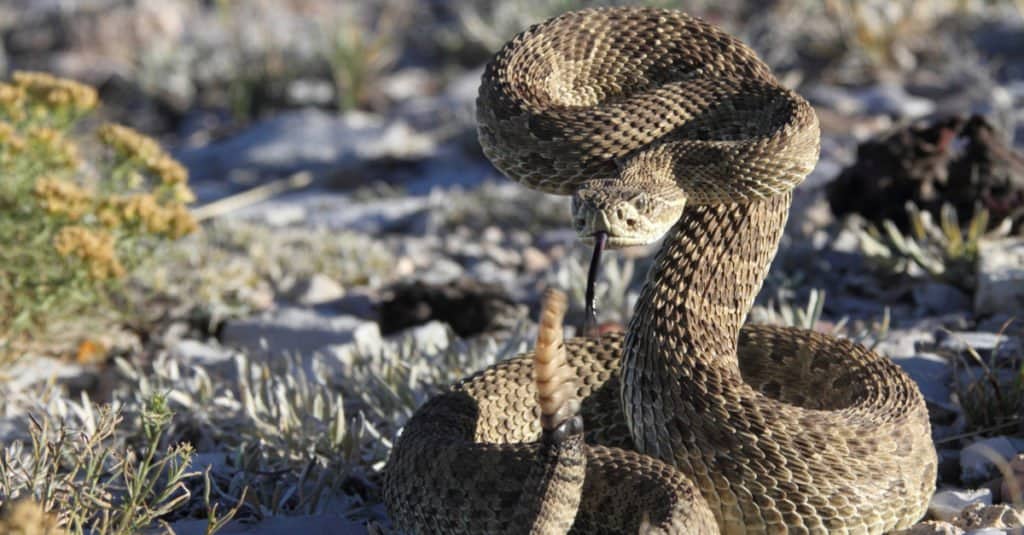
Prairie rattlesnakes are the second biggest venomous snake in Nebraska and the most common.
©Harris Motion Photo/Shutterstock.com
Prairie rattlesnakes are the most common venomous snake in Nebraska. They’re the second-biggest and mostly occur in the western two-thirds of the state.
These snakes love prairie dog towns, grass prairie, and rocky outcrops. Prairie rattlesnakes usually range between three and five feet in length. Prairie rattlesnake colorations run the gamut and include all shades of brown, green, and gray-green with darker blotches on their back. Like other western U.S. rattlesnakes, these rattlers have dark and light banding on their tails right before the rattle.
They’re most active from late March to early November and eat small mammals with the occasional bird or lizard for variety.
Timber Rattlesnake (Crotalus horridus)
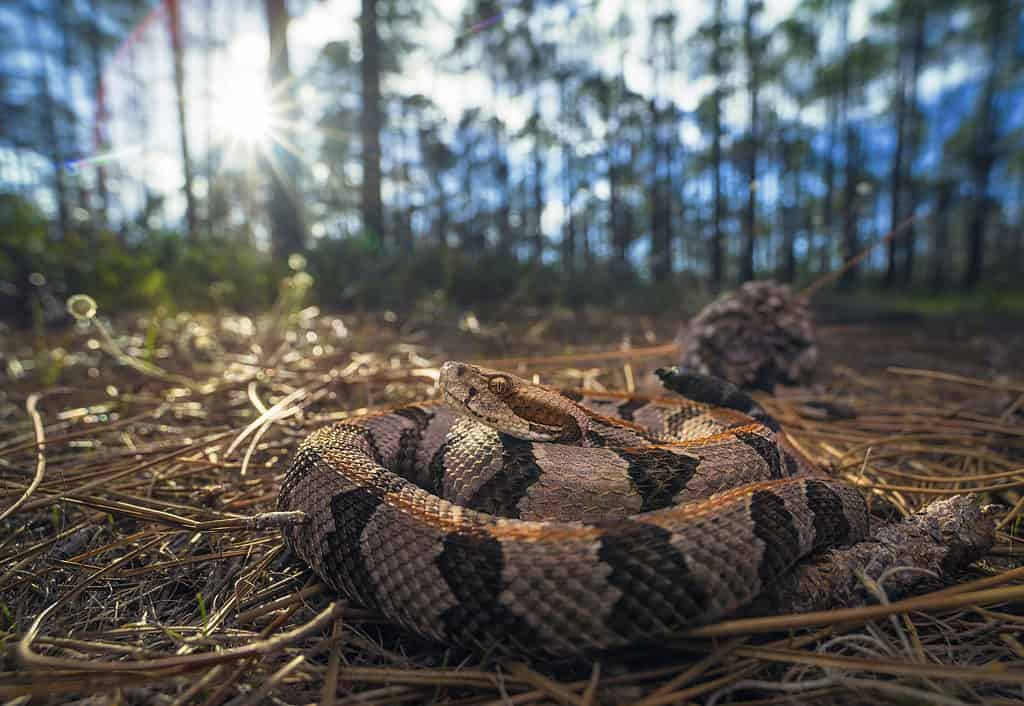
The biggest rattlesnake in Nebraska is also one of the rarest. Timber rattlesnakes are only in the southeastern corner of the state.
©Kristian Bell/Shutterstock.com
Known for being the snake on the Gadsden Flag, timber rattlesnakes are one of the calmest rattlers. With a lighter background and black M or V-shaped crossbands, this is a distinctive species. Some also have a reddish-orange dorsal stripe between the markings.
Although they are the biggest rattler in Nebraska, sometimes growing over six feet long, timber rattlesnakes only strike when provoked. They generally need to be really aggravated by being stepped on or grabbed.
These snakes are rare and only occur in a small area in the southeastern corner of the state. Timber rattlesnakes are most active between early April and late fall.
| Snake | Region | Venomous | |
|---|---|---|---|
| 1 | Prairie Rattlesnake | Western 2/3 of Nebraska | Yes! |
| 2 | Timber Rattlesnake | Southeastern corner | Yes! |
| 3 | Eastern Copperhead | Southeastern corner | Yes! |
| 4 | Prairie Massasauga | Southeastern Nebraska | Yes! |
| 5 | Eastern Hognose | Southwestern pocket and northeastern Nebraska | Yes, but harmless to humans |
| 6 | Western Hognose | Western 2/3 of Nebraska | Yes, but harmless to humans |
| 7 | Western Ratsnake | Eastern edge of the state | No |
| 8 | Western Foxsnake | Eastern 1/4 of Nebraska | No |
| 9 | Speckled Kingsnake | Southeastern corner | No |
| 10 | Western Milksnake | Widespread | No |
| 11 | Plains Garter Snake | Widespread | No |
| 12 | Western Worm Snake | Southeastern corner | No |
| 13 | Smooth Green Snake | Central and eastern Nebraska | No |
| 14 | Red-Bellied Snake | Central Nebraska | No |
| 15 | Bullsnake | All of Nebraska | No |
| 16 | North American Racer | All of Nebraska | No |
The photo featured at the top of this post is © Cherdchai Chaivimol/Shutterstock.com
Discover the "Monster" Snake 5X Bigger than an Anaconda
Every day A-Z Animals sends out some of the most incredible facts in the world from our free newsletter. Want to discover the 10 most beautiful snakes in the world, a "snake island" where you're never more than 3 feet from danger, or a "monster" snake 5X larger than an anaconda? Then sign up right now and you'll start receiving our daily newsletter absolutely free.
Thank you for reading! Have some feedback for us? Contact the AZ Animals editorial team.







